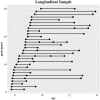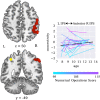Mechanisms of interactive specialization and emergence of functional brain circuits supporting cognitive development in children
- PMID: 30631462
- PMCID: PMC6220196
- DOI: 10.1038/s41539-017-0017-2
Mechanisms of interactive specialization and emergence of functional brain circuits supporting cognitive development in children
Abstract
Cognitive development is thought to depend on the refinement and specialization of functional circuits over time, yet little is known about how this process unfolds over the course of childhood. Here we investigated growth trajectories of functional brain circuits and tested an interactive specialization model of neurocognitive development which posits that the refinement of task-related functional networks is driven by a shared history of co-activation between cortical regions. We tested this model in a longitudinal cohort of 30 children with behavioral and task-related functional brain imaging data at multiple time points spanning childhood and adolescence, focusing on the maturation of parietal circuits associated with numerical problem solving and learning. Hierarchical linear modeling revealed selective strengthening as well as weakening of functional brain circuits. Connectivity between parietal and prefrontal cortex decreased over time, while connectivity within posterior brain regions, including intra-hemispheric and inter-hemispheric parietal connectivity, as well as parietal connectivity with ventral temporal occipital cortex regions implicated in quantity manipulation and numerical symbol recognition, increased over time. Our study provides insights into the longitudinal maturation of functional circuits in the human brain and the mechanisms by which interactive specialization shapes children's cognitive development and learning.
Conflict of interest statement
The authors declare that they have no competing financial interests.
Figures





References
-
- Menon, V. Systems neuroscience of cognitive development: what does the future hold? in Cambride Encyclopedia of Child Development (Cambridge University Press, Cambridge, UK, 2015).
Grants and funding
LinkOut - more resources
Full Text Sources

